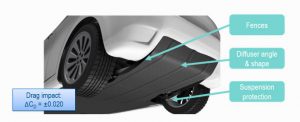There’s no question that vehicle electrification and autonomy are two of the biggest trends driving automotive design and engineering today. Exa’s recent webinar, Aerodynamic Design for Electric Vehicles, hosted by industry partner Automotive Megatrends, invited great discussion with our attendees about that topic. Many of their questions – with answers by Exa’s top subject matter experts on aerodynamic efficiency and soil and water management – are below.
This first round of Q&A with Exa’s webinar attendees focuses on improving EV aerodynamics for better battery life and range. The second round – to be posted in the next blog article in this series – discusses the best design changes to keep autonomous vehicle sensors and camera systems clean and clear of dirt, dust, and water. (To hear the webinar, click here.)
Are car makers currently going out of their ways to make EVs look like “normal” cars, and do you envision any design trends specific to EVs that perhaps are not possible with traditional gas vehicles?
Exa does a lot of work globally in aerodynamics, so we have a chance to see this thinking at work. We see that a lot of the work being done in order to differentiate EVs leads OEMs to create more unique styles that somehow “speak the language” of being electric. That’s also promoted by alternate packaging: you have the vehicle, and components, and different requirements on the front end. I think the EVs that will be successful will try to differentiate themselves in the market. This is really a consumer question: what will consumers want from an electric vehicle?
Since the underbody is flat, this gives new space for design features. Are there new features that can help manage the tire wake that can be located on the underbody, and what approach would you propose in order to find these sensitivities?
Yes – definitely. This is a very active area of investigation. I think you will see that it’s not just a simple, flat underbody, but it’s a very sculpted shape, or a shape that has a lot of aero devices, because it is very challenging to keep that high-speed flow from just slamming into those components around the wheels.

I think it’s a more complex design problem than it looks like, and you’ll see a lot of shape and features of the underbody to try and protect the wheels. It’s also closely coupled to the body design and the wheel rim design, so there’s a lot of effort there to collaborate across those design areas to produce smaller wheel wakes on both front and rear. The front wheel wake trajectory should help keep the flow directed at high speeds in the central underbody region.
How far would the range of an EV with a 200 km charge be increased with better aerodynamic design?
At high speeds on the highway, a 10% drag improvement would give an 8% increase in the range. In fact, improving designs for range is closely correlated to improving design for aerodynamics, since aerodynamic drag is the top contributor to limited EV range at highway speeds. For example, at 130 kph (80 mph), the vehicle uses most of its energy to combat aerodynamic resistance – as much as 80% of the power used at this speed for a typical electric vehicle goes to overcome aerodynamic losses, while only 20% overcomes mechanical losses. This means that, if I could improve the aerodynamics of the vehicle 5%, I can increase the range 4% at that speed. Another way to increase the range 4% is to buy a bigger battery. But a bigger battery costs more and it weighs more – so that’s not the best way to increase range. Aerodynamics is the more cost-effective way to maintain or improve EV range.

Are you aware of aerodynamic improvements to electric vehicles as they go through their lifecycle – as in a design refresh, for example? Reason being, we hear – as consumers – of tire improvements and battery improvements, but are you aware specifically of aerodynamic improvements?
Our experience at Exa is in the beginning to end process of designing the vehicle, and how critical aerodynamic improvements have been during each stage, from initial concept, to a refined prototype, to the final released vehicle, aerodynamic improvements have been huge. And sometimes you can’t see that much difference in the vehicle appearance as it goes through those different stages, but vehicles cannot be released that don’t meet the range requirements that consumers are expecting. So the aerodynamic development has been a huge part of successfully releasing electric vehicles for all of the EVs that we’re aware of.
Is there a speed above which, or below which – or is there a tipping point speed – where it suddenly becomes economically viable to make aerodynamic changes to a vehicle? For example – in lower-speed robotaxis operating in urban areas, would aerodynamic drag play any kind of role with those vehicles, operating at very low speeds with a lot of starting and stopping?
Aerodynamics measures the power loss due to wind resistance, which increases with the cube of velocity. It is a significant effect at high speed, and at low speed it’s not as significant. The cut-off where it’s about 50/50 in aerodynamic resistance and mechanical losses is somewhere at low highway speed – and it depends on the vehicle exactly where that cut-off is. But for gasoline vehicles, we often use this 2:1 ratio – that a 2% drag improvement will get you a 1% improvement in fuel economy at highway speed, but at higher speeds it becomes a more significant trade-off. Because mechanical losses tend to be less for electric vehicles, that trade-off is even more significant.
The next blog in this series answers additional questions on camera and sensor placement to reduce soiling during autonomous vehicle design, or click here to view the entire webinar.
Want to learn more about Dassault Systèmes’ simulation solutions for electric vehicles? Visit: go.3ds.com/TrustTheDrive
